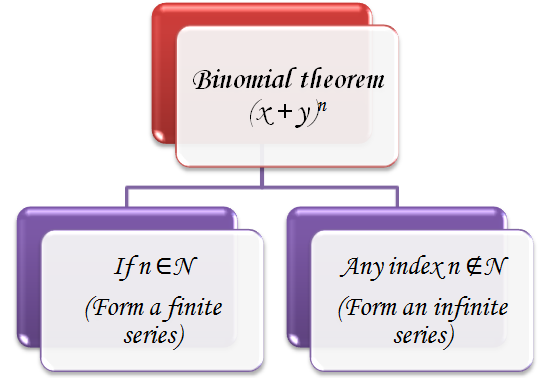Revision Notes On Binomial Theorem
-
If x, y ∈ R and n ∈ N, then the binomial theorem states that
(x + y)n = nC0xn + nC1 xn-1y + nC2 xn-2 y2 +…… … .. + nCrxn-r yr + ….. + nCnyn
which can be written as ΣnCrxn-ryr. This is also called as the binomial theorem formula which is used for solving many problems.

- Some chief properties of binomial expansion of the term (x+y)n:
-
The number of terms in the expansion is (n+1) i.e. it is one more than the index.
-
The sum of indices of x and y is always n.
-
The binomial coefficients of the terms which are equidistant from the starting and the end are always equal.
- Such an expansion always follows a simple rule which is:
-
The subscript of C i.e. the lower suffix of C is always equal to the index of y.
-
Index of x = n – (lower suffix of C).
-
The (r +1)thterm in the expansion of expression (x+y)n is called the general term and is given by Tr+1 = nCrxn-ryr
-
The term independent of x is obviously without x and is that value of r for which the exponent of x is zero.
-
The middle term of the binomial coefficient depends on the value of n. There can be two different cases according to whether n is even or n is odd.
-
If n is even, then the total number of terms are odd and in that case there is a single middle term which is (n/2 +1)th and is given by nCn/2 an/2 xn/2.
-
On the other hand, if n is odd, the total number of terms is even and then there are two middle terms [(n+1)/2]thand [(n+3)/2]th which are equal to nC(n-1)/2 a(n+1)/2 x(n-1)/2 and nC(n+1)/2 a(n-1)/2 x(n+1)/2
-
The binomial coefficient of the middle term is the greatest binomial coefficient of the expansion.
-
Some results which are applied in binomial theorem problems are
-
nCr + nCr-1 = n+1Cr
-
nCr = n/r (n-1Cr-1)
-
nCr/nCr-1 = (n – r + 1)/r
-
[(n+1)/(r+1)] nCr = n+1Cr+1
-
Some of the standard binomial theorem formulas which should be memorized are listed below:
-
C0 + C1 + C2 + ….. + Cn= 2n
-
C0 + C2 + C4 + ….. = C1 + C3 + C5 + ……….= 2n-1
-
C02 + C12 + C22 + ….. + Cn2 = 2nCn = (2n!)/ n!n!
-
C0Cr + C1Cr+1 + C2Cr+2 + ….. + Cn-rCn = (2n!)/ (n+r)!(n-r)!
-
We can also replace mC0 by m+1C0 because numerical value of both is same i.e. 1. Similarly we can replace mCm by m+1Cm+1.
-
Note that (2n!) = 2n. n! [1.3.5. … (2n – 1)]
-
In order to compute numerically greatest term in a binomial expansion of (1+x)n, find Tr+1 / Tr = (n – r + 1)x / r. Then put the absolute value of x and find the value of r which is consistent with the inequality Tr+1 / Tr> 1.
-
If the index n is other than a positive integer such as a negative integer or fraction, then the number of terms in the expansion of (1+x)n is infinite.
-
The expansions in ascending powers of x are valid only if x is small. If x is large, i.e. |x| > 1 then it is convenient to expand in powers of 1/x which is then small.
-
The binomial expansion for the nth degree polynomial is given by:

-
Following expansions should be remembered for |x| < 1:
-
(1 + x)-1 = 1 – x + x2 – x3 + x4 - ….. ∞
-
(1 – x)-1 = 1 + x + x2 + x3 + x4 + ….. ∞
-
(1 + x)-2 = 1 – 2x + 3x2 – 4x3 + 5x4 - ….. ∞
-
(1 - x)-2 = 1 + 2x + 3x2 + 4x3 + 5x4+ ….. ∞
-
An important result:
For sums involving product of two binomial coefficients the folliwng result is used:
nC0 mCk + nC1mCk-1 + nC2mCk-2 + …. + nCkmC0 = m + nCk
-
In order to find the integral part of the expression N = (a + √b)n (n ∈ N)
Step 1: Consider N’ = (a -√b)n or (√b – a)n according as a > √b or √b > a.
Step 2: Use N + N’ or N – N’ such that the result is an integer.
Step 3: Use the fact that N = I + t, where I stands for [N] and t for {N}.
-
When n is a negative integer or a fraction then the expansion of a binomial is possible only when:
(a) its first termis 1.
(b) the second term is numerically less than 1.
-
Hence, when n does not belong to n and |x| < 1, then it states that
(1 + x)n = 1 + nx + n(n-1)x2/2! + n(n-1)(n-2)x3/3! + …. n(n-1).. (n – r + 1)xr/r! + … ∞
-
General term:
Tr+1 = n(n-1)(n-2) .. .(n – r + 1). xr/r!
In this expansion there are infinite terms.
In this case, the differnet terms cannot be expressed as nC0, nC1, … because n is not a positive integer.
-
In order to find the sum of an infinite series, we can compare the given infinite series with the expansion of (1+x)n = 1 + nx + n(n-1)/2! x2 + … and by finding the value of x and n and putting in (1+x)n the sum of series is determined.
View courses by askIITians


Design classes One-on-One in your own way with Top IITians/Medical Professionals
Click Here Know More

Complete Self Study Package designed by Industry Leading Experts
Click Here Know More

Live 1-1 coding classes to unleash the Creator in your Child
Click Here Know More
